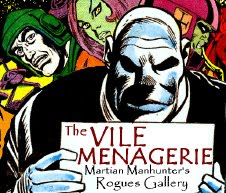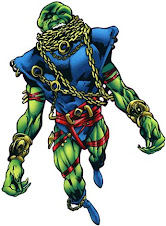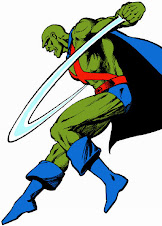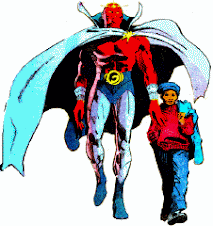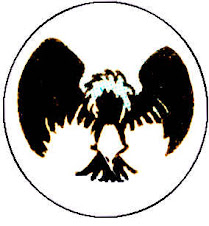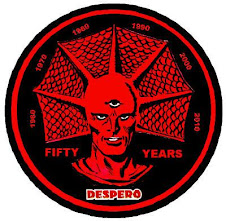 Forensic Psychiatrist Dr. Michael Stone's Scale of Evil Rank
Forensic Psychiatrist Dr. Michael Stone's Scale of Evil Rank
19)
Psychopaths driven to terrorism, subjugation, intimidation and rape, but short of murder.
Why Commander Blanx has been selected for 1st Place:
- Commander Blanx was the Martian Manhunter’s first enemy… sort of.
Super-hero fans place a lot of stock in “ages,” or rather periods of time usually running a decade & a half reflecting prevalent trends in the genre. There’s usually some gray area around when an age begins or ends. The Silver Age wrapped sometime between the late ‘60s and early ‘70s, which would make Commander Blanx the Martian Manhunter’s last foe before the close of the era that birthed him. However, Blanx was decidedly darker than the Silver Age model thief/thug, and was created by one of the defining writers of the ’70s, Denny O’Neil. Therefore, I’m inclined to consider Blanx the first of the Bronze Age. However, Blanx directly if retroactively ties into the Martian Manhunter’s earliest stories, including an animosity that dates back to before the first J’onn J’onzz tale. Most importantly, Commander Blanx was the first Martian Manhunter villain to lay claim to that distinction, uncontested for thirty years. Plus, if anybody brought an end to J’onn J’onzz’s Silver Age, it was Blanx.
- Commander Blanx was the Martian Manhunter’s opposite number in his life on Mars
Before coming to Earth, J’onn J’onzz was a science leader for the green Desert Dwellers who fought a civil war against the leader of the Pale Martian Pole Dwellers, Commander Blanx, over an energy resource. Besides having similar powers and appearance, the characters also paralleled in their prominent leadership roles amongst their people.
- Commander Blanx was partially responsible for J’onn J’onzz’s exile to Earth.
Through treachery, Blanx defeated J’onn J’onzz, tried him in a kangaroo court, and sentenced him to thirteen years of exile to the wastelands of Mars. It was from this isolated location that J’onn was unintentionally teleported to Erdel’s lab. It makes a lot more sense for J’onzz to be singled out if Erdel’s robot brain were, say, teleporting any sentient life within a five mile area, rather than being one Martian amongst a throng. Also, Blanx provided J’onzz a reason to stay on Earth, even after he had multiple opportunities to return home. Surely J’onn longed for Mars, but better to remain on Earth than to wander alone outside society. Without Commander Blanx, we may have never benefited from a Manhunter from Mars.
- Commander Blanx was the first Martian to come to Earth gunning for J’onn J’onzz.
Quite a few Martians found their way to Earth in the Silver Age, and as soon as they came up on J’onn’s radar, he worked to send them packing (even his own brother.) They were usually on Earth by accident, and some were more aggressive about trying to stick around than others. Only Commander Blanx intentionally made a trip to Earth for the specific purpose of attacking him nemesis, the Manhunter, and then leaving. It didn’t work out as planned, but at least he didn’t try to conquer the planet or anything similarly cliché.
- Commander Blanx introduced retroactive continuity as a regular component of Manhunter’s story.
J’onn J’onzz hit the ground running in 1955, occasionally noting elements of Martian history and culture, but really living in the now. His strip wasn’t big on flashbacks, and every villain that showed up was meeting the Alien Atlas for the first time. The arrival of Commander Blanx changed everything, adding a sprawling new backstory for the character before he was known as the Martian Manhunter, and then reinventing the creation of the Justice League in his second appearance. Ever since, the Manhunter’s continuity has been especially fluid, and in fact even nostalgists like Alex Ross consistently ignore his Pre-Crisis solo history. Truly, the popular conception of the Martian Manhunter is better defined by retroactive continuity than anything laid down in his solo strip.

- Commander Blanx is one of the few ties between the Silver and Bronze Age Manhunter stories, enforcing the former’s relevance in Pre-Crisis continuity.
No one, not even the
Manhunter from Mars creative team, cared about J’onn J’onzz solo stories. Elements in the feature contradicted each other, and little things like the name of John Jones’ town went unanswered for years. A couple of his strip’s villains turned up in early issues of
Justice League of America, but with one exception, that book simply assigned the Alien Atlas unaffiliated villains after that. At least there was a
JLofA issue after J’onn had unofficially left the team that referenced his battles with Vulture in his own strip, but otherwise the Manhunter’s solo series had no bearing outside his own fan following.
As a novel exercise, scripter Steve Englehart set a flashback issue of
JLofA during a specific publishing month early in the Silver Age. It was fun to learn that Green Arrow wasn’t present because he was trapped on an island that month, or that Hal Jordan appeared sans power ring because he hadn’t met Abin Sur yet. However, the story pivoted on a random
Manhunter from Mars strip centering on weapons teleporting from Mars into the hands of gangsters. As it turned out, this was a trial run for Commander Blanx and his men to come to Earth in pursuit of J’onn J’onzz, drawing them into conflict with other contemporary heroes. Until Grant Morrison brought back the Human Flame for
Final Crisis, the rest of the DC Universe could disregard everything from the
Manhunter from Mars strip except his origin and Blanx’s tie-in story, affording those surrounding stories greater validity. Compare that to Aquaman, Green Lantern, Wonder Woman, and the Flash, whose statuses were constantly updated and referenced based on the going on in their solo series. The Martian Manhunter’s solo happenings usually only related to his absence from activity, but here was a key story that pivoted on his life.
- Commander Blanx “introduced” J’onn J’onzz to the world’s greatest super-heroes.
The Martian Manhunter had been active in comics for several years before turning up as a founding member of the Justice League. Prior to that team’s first appearance, the Alien Atlas hadn’t joined any other heroes for an adventure, and even their later origin hadn’t revealed the specifics of how J’onn had become acquainted with his future teammates. Part of Blanx’s plan to draw J’onzz out in the open was to reveal the existence of Martians on Earth, which also attracted the attention of Earth’s heroes. Through Blanx’s scheme, J’onzz met the Flash, Batman, Robin, Superman, Wonder Woman, Aquaman and Hal Jordan, who all agreed to keep the existence of the Martian Manhunter a secret until he was “outed” by B’rett a year later. Prior introductions have since been retconned, but this was the first attempt at connecting J’onn J’onzz to his fellows prior to forming a super-team.
- Commander Blanx also better associated America’s heroes with one another.
For the most part, DC properties existed in their own separate continuities that only overlapped on occasion through the Silver Age. Superman, Batman and Robin comprised the “World’s Finest” in their own magazine, and there were the Justice Society of America cases, but their interaction died out with the Golden Age. Through Blanx’s scheme, the Flash and the future Green Lantern retroactively met other heroes not sharing their name for the first time. I’m not sure whom Wonder Woman had met by that point, and I doubt Aquaman knew anyone outside of maybe Superman. Plus, the event gathered a mob of heroes for the first (and in some cases only) time ever, like the Challengers of the Unknown, Robotman, Vigilante, Adam Strange, and many more. Heck, I think this was even Plastic Man’s first DC-centric adventure after some ill-fated post-Quality Comics revival attempts. Relative to the 1950s, Commander Blanx essentially rebuilt the DC family of properties as an in-continuity collective.
- Commander Blanx was the catalyst for the formation of the Justice League of America.
The JLofA fought Starro the Conqueror in their debut story, but the circumstances of their official formation were not revealed until several years later, when they were shown to combine forces against an Appellaxian invasion. However, a further wrinkle was introduced in the 1970s. While the short-lived “Martian Invasion” brought out a host of period heroes, only Superman, Batman, Wonder Woman, the Flash and Aquaman were at the right place and time to decide to form a new super-team for the Silver Age. However, they wanted to include the Martian Manhunter, and felt the general public needed time to forget their concerns about Martians and accept J’onn J’onzz as a fellow hero. To that end, they decided to wait a year before officially announcing themselves as a collective. By that point, the also present Hal Jordan had become Green Lantern, and the absent Green Arrow would join up a few months later (although he would remain unaware of their true origin for years.) So basically, that makes Commander Blanx one of the most important villains in DC Comics’ history.

- Commander Blanx helped turn the Martian Manhunter into a period hero.
The story that reintroduced Commander Blanx was set in a specific month in 1959, referencing the events in the various titles of the story’s major players published that month. That wasn’t as big of a deal less than twenty years later, when the retcon saw print. However, you know DC wasn’t going to allow their name brands to be moored to that one year permanently, instead sliding the timeline as the years passed. Yet, the tale belonged to J’onn J’onzz, it was an essential part of his pre-Crisis backstory, and it wouldn’t work outside its period setting. Thankfully, as an alien, J’onzz could age differently than humans, and remain a McCarthy era hero while his contemporaries became comparative rookies. This move has helped set J’onn J’onzz apart from both standard super-heroes and fellow aliens by giving him a more fleshed out backdrop than “visiting alien,” which baby boomer writers have made fine use of.
- The New Frontier, America Secrets and other great comics exist in part because of Commander Blanx
Again, Steve Englehart’s Blanx story was highly influential, retroactively establishing a shared universe amongst virtually all of DC’s Silver Age properties, and clearly seeding Darwyn Cooke’s magnum opus. Also, without J’onn J’onzz being established as a period character through that story, high water marks like Mark Verheiden’s
Secret Origin and McGreal & Rawson’s “Heat Wave” wouldn’t have come into being. Not only would Martian Manhunter’s catalog be far poorer without Englehart’s seminal script, but DC’s collected editions department as well.
- Commander Blanx turned the Martian Manhunter into a nearly peerless veteran hero.
J’onn J’onzz missed the Golden Age, when most of the iconic DC brands were established. Superman, Batman, Wonder Woman, the Flash, Aquaman, Green Arrow, Hawkman, the Atom, Black Canary—all of DC’s biggest guns’ legacies had a decade or better on the Manhunter from Mars, and even their Silver Age counterparts were nipping at J’onn’s feet. It’s safe to say the Sleuth from Outer Space wasn’t remarkable enough on his own to warrant more than the historical footnote status Captain Comet enjoys. However, he will always be remembered as a founding member of the Justice League, and thanks to his being a period character and his contemporaries being eternally twenty-eight, the Martian Manhunter is now treated as a veteran super-hero with decades of experience over DC’s Trinity, and essentially the only major hero active between the end of the Golden Age and the ever later dawn of the Modern Heroic Age. Blanx delivered decades of uniqueness, story potential, and relevance to what was once an also-ran hero.

- Commander Blanx popularized xenophobia as a major theme in Manhunter stories.
After Professor Erdel stroked out on him, J’onn J’onzz was rightly concerned about the negative impact his presence on Earth could cause. J’onzz was our secret benefactor for years, until B’rett forced the revelation of a Manhunter from Mars in our midst. Contrary to his fears, the Alien Atlas was immediately embraced as a hero, allowed to join the Justice League of America, serve as protector of Middletown, and even worked for government agencies as a crimebuster. Once again, Commander Blanx ruined everything. The retroactive community that always followed him forced the JLofA to delay their debut because of the filthy Martian among their ranks, and the primary explanation for J’Onzz not being well known between 1955 and the Modern Heroic Age was his status as an alienated alien watching over a fearful humanity. Humans distrusted J’Onzz, and so did his teammates, very nearly costing lives. That just was not an issue before 1977, and it was created by the arrival of Blanx.
- Commander Blanx was the first Pale Martian, and introduced racism as a dominant theme in Manhunter comics.
B’rett may have been the first “off-color” Martian, but his yellow skin was a subtext at best. The Martian Civil War divided the planet by race, with J’onn J’onzz commanding the greens and Blanx commanding the whites. You knew the Desert Dwellers were the good guys, because they wanted to use the Blue Flame of Mars for space travel, just like the Kennedys. You knew the pallid Pole Dwellers were evil, because their liberal creator suffered from an history case of white guilt, and because they wanted the Blue Flame for vague military purposes that ended in genocide. Further, the descendant White Martians used by Grant Morrison were even more hostile, alien and evil, forcing the peaceful, darker-skinned minority greens to heroically save the day. The Whites even managed to come up with Red Martians, a.k.a. Saturnians, to enslave. Racial politics now define the Martian race at DC Comics, and Blanx was at the forefront of that development.
- Commander Blanx turned the Martian people into aggressive militaristic invaders.
There have always been criminal Martians, and when they reach Earth, they just love rioting and stealing in a spree. However, these were a few bad apples that needed to be wrangled by the Martian Manhunter, not a representation of the gentle, futuristic race as a whole. That is, until Commander Blanx’s onslaught destroyed Martian society forever. Virtually every other Martian that has turned up since has tried to conquer or destroy our planet, or at least torture/mutate/kill as many puny humans as they can get their shape-shifting appendages around. Blanx gave the Martian race a bad name they have yet to live down forty years later.
- Commander Blanx was the first Martian to kill just about every other Martian.
You know, the Phantom Zone criminals got up to some really abhorrent doings, but none of them successfully killed 99% of all Kryptonians. I don’t even think any tried. That scale of genocide is so horrific and ultimately pointless, few super-villains are so hollow as to go that route. Commander Blanx was such a creature, annihilating his own race for personal gain, and standing as the butcher of Martian life for twenty years. Although it was never explicitly stated, J’onn’s parents and brother must have burned to death in the flames, since they were never spoken of again. For another ten years, the death of Martian society was assigned to a plague, until Malefic was created to claim credit for its creation. Regardless, Blanx got their first.
- Commander Blanx killed the planet Mars.
Besides riding on Blanx’s coattails, Malefic came up a bit short on impact. When Commander Blanx let loose the Blue Flame of Mars, he destroyed a society established and maintained over the previous thirteen years of comics publishing. Further, where H’ronmeer’s Curse simply wiped out the Green Martians, the Blue Flame rendered the entire planet Mars completely uninhabitable. From 1969-1988, nothing lived there, no structures stood, hardly anyone visited—it was entirely desolate. After 1988, J’Onn J’Onzz made irregular pilgrimages to his home world, and the 1998 series features all sorts of buildings/vegetation/life forms remaining on Ma’aleca’andra. Most importantly, whether you believe DeMatteis or Ostrander’s take on a Mars, it had been a wasteland for decades prior to their involvement. Commander Blanx left Mars deader than anyone, and authored the very premise, which despite its variations has been set in place ever since.
- Commander Blanx redefined the Martian Manhunter as a tragic character.
The cheerful Alien Atlas from
Detective Comics and most of the
House of Mystery run is almost unidentifiable to a latter day fan. Captain Harding who? The Idol-Head of what now? And he had a baby-talking pet? The Martian Manhunter’s powers and much of his general appearance were quite dissimilar from the modern day as well. That change began with Commander Blanx, who wiped out J’onn’s family, his people, his past life—everything the Martian Manhunter had been was burned away. The debut of “our” Martian Manhunter was not 1955, but 1969, as a crumple figure devastated by all the death he failed to prevent. At first, this made J’onn J’onzz even more of a Superman knock-off. However, much of the science fiction and melodramatic elements of Superman comics had been shed by the 1970s, and were almost wholly abandoned by the mid-80s, so that the spirit of Mort Weisinger’s Silver Age Superman is now embodied by the Martian Manhunter.
- Commander Blanx defined every Bronze Age Martian Manhunter story, helped differentiate the Alien Atlas from the Man of Steel, and was “the” villain of note for decades.
Mars was about as dead as Krypton, the home world Superman was always travelling through time to never quite save in the Silver Age. That didn’t get in the way of the Man of Tomorrow’s contemporary adventures with the World’s Finest or JLofA, though. Martian Manhunter, on the other hand, made it back to Mars just in time to create a space ark using techniques he had learned on Earth to save every Martian still living through 1988. J’onn J’onzz also dropped everything to find the people who left Mars without him, and upon doing so, acted as their leader through over a decade of hardship trying to eke out an existence on harsh alien worlds. Unlike Superman, the Manhunter saved and supervised what was left of his people, rather than continue adventuring with his super friends. This responsibility was the basis for every Manhunter story through 1984, and almost every adversary he faced over those years (Bel Juz, N’or Cott, Re’s Eda, the Marshal) was a comparatively tepid variation on Commander Blanx. In fact, until the animosity between Martian Manhunter and Despero hit a fever pitch in the early ‘90s, there were no other truly compelling villains up for consideration as J’Onn’s nemesis outside Blanx.

- Commander Blanx was a Justice League of America caliber threat.
Every other month in a Superman comic, the entire Justice League is beaten by some piker, jobbed to make the Man of Steel look more endowed in his little red trunks. Green Lantern, the Flash, and Wonder Woman get a little of that kind of service now and again. Aquaman has only gotten to play that card once or twice, and the Martian Manhunter had to team up with his, Malefic, to halfway do the job. Batman of course is such a pro-fic favorite he gets to do it regularly in the actual
League title, which is the way to get fans’ attention. It’s great that Malefic could deal damage in the
Martian Manhunter series, but he’ll never get the visibility of Darkseid or Despero in that ghetto title.
Commander Blanx was the first villain specifically created to battle the Martian Manhunter
and the Justice League, on the group’s turf. Commander Blanx and his men beat J’onn J’onzz in 1959, and it took most of the heroes who would form the Justice League to save him. In 1969, Commander Blanx successfully destroyed Mars, and all the League could do was bring him to justice over the crime, a literally pyrrhic victory. The simple fact that Blanx is a Manhunter villain who faced the League twice in a decade is enough to crow about, but to have distributed such widespread destruction under their watch is especially memorable. You may recall that Malefic had already been captured by Manhunter, released, plagued Mars, and thought dead before Batman was even born. Blanx did his dirty business right under the Dark Knight’s nose.
- Commander Blanx was the Martian Manhunter’s first apparent kill.
J’onn J’onzz had varying degrees of responsibility in a number of criminal deaths in his presence during the waning days of his
House of Mystery run, but there isn’t a lot of blood directly on his hands. He made a point of saying he was going to kill Malefic, and then doing so, but the only other seemingly calculated execution was Blanx’s. After the destruction of Mars, the Commander and the Manhunter engaged in armed combat until J’onzz smashed Blanx with a globe, proceeded by a seemingly lethal fall. No body was buried on-panel, and the death was never confirmed in dialogue, but it was certainly insinuated. To date, Commander Blanx has made no return to life, so for now, murder was the case.
- Commander Blanx was in the Super Powers Collection-- sorta.
Blanx was one of the two enemies listed in the Martian Manhunter biography on the back of his
Super Powers Collection action figure packaging card.
- Commander Blanx was not a carbon copy of the Martian Manhunter, and was his first archetypal super-villain.
As has been repeatedly noted in the past, the
Manhunter from Mars strip wasn’t exactly a breeding ground for unique, sustainable villains. There were a whole lot of gangsters, oodles of mad scientists, some ridiculous themed thieves, and when things got semi-serious, a bad Martian. Typically, the latter were virtual duplicates of J’onn J’onzz, with either mild color or costume variations. There were exceptions, like the Martian Mandrills, Tor and Vulkor, just as Prof. Hugo and Mr. V were a cut above the other human enemies. Still, no one screamed “super-villainous archrival” before Commander Blanx. More than just the evil duplicate of our hero, Blanx was able to appear as the same species as J’onzz, but clearly from a different race, culture, and moral code. Blanx had enough in common with J’onzz to be a roughly equal adversary, while still function in a vastly different manner. Blanx had underlings and schemes and motivations perfectly in line with classic bad guys which also served to contrast him against his enemy without simply being a clear cut diametric opposite. This made Blanx feel less contrived than a B’enn B’urnzz or a Malefic, while still serving much the same function.
- Commander Blanx is the ultimate embodiment of the betrayal of Martian principles.
Malefic may have had an aberrant personality, but there was a disconcerting intimacy between him and his victims that seemed a twisted reflection of Martians’ telepathic bonds. He may have mind raped his own mother and sister-in-law, but there was still that sickening closeness to consider. Like his brother, Ma’alefa’ak clearly had an interest in philosophy, and was a devout theologian who simply worshipped different gods than H’ronmeer. Malefic was J’onn J’onzz’s twin brother, growing up in the same household and culture, more often than not going through the motions of being a proper Martian. For whatever reason, Malefic couldn’t stand society, but he cared enough about it to make its destruction his life’s greatest work.
Commander Blanx cared about absolutely nothing but himself. He cast aside a millennium of peace on Mars to wage a civil/racial war. In man-to-man combat with J’onn J’onzz, he brought in another man to sucker punch his foe. Blanx insinuated himself deeply into the Martian hierarchy solely to satisfy his personal ambition. Finally, he destroyed all of Mars, not because of emotional problems or divine direction, but simply to satisfy his own greed and disdain for the “weakness” of his people. Malefic may have been the nastiest Martian around, but Blanx was the antithesis of Martian ideals, so completely soulless as to be exempted from any connection to his people.
 The Counter Argument:
The Counter Argument:
- Commander Blanx appeared in two comics book nearly thirty-five years ago, and he doesn’t even have his own Wikipedia page.
- Blanx was never a physical challenge for the Martian Manhunter, always falling back on weapons and underhanded plays. He even died like a sissy, screaming as he fell off a friggin’ staircase to his death-by-globe.
- That plunging neckline from his first appearance is reason enough to blackball him, but coupled with the hideous color scheme, the man’s an eyesore.
What Commander Blanx Represents:
J’onn J’onzz has a simple name and garb. His green skin represents life and vitality, and its lack of covering honesty. What clothes J’onn wears are a noble blue. He has a loving family, and his people embrace peace. When presented with a power source, he wishes to use it for exploration and advancement. When trapped on an alien world against his will, he chooses to secretly act as its benefactor. J’onzz joins a cooperative of good Samaritans in this endeavor. J’onzz is the favorite son of Mars, and an ambassador of goodwill to other worlds.
Blanx has no first name, only a title. His skin is absent of color, cold and pale as a corpse, and almost entirely concealed in regal garb. Their sickly orange and green color scheme highlights his otherness from humanity, and Blanx was never without a lethal weapon of some kind. Blanx has no significant others to speak of, only nameless minions serving as his hostile army. When presented with a power source, he uses it to kill as many people and destroy as much property as possible. Even conquering his own world isn’t enough to satisfy Blanx, so he sells out all other Martian life to the highest bidder. Blanx is a commander, seeking to subjugate and dispose of lackeys at will. Blanx was the antichrist of Mars, and a criminal everyplace else.
As J’onn J’onzz put it, "We were so close! After untold hundreds of centuries, we were about to find maturity... outgrow senseless strife... become all we might have been! And one individual, sick with the need for violence, deprived us of our destiny! And so my world ends!"
Analogies:
- Commander Blanx is to the Martian Manhunter as…
Ra’s al Ghul is to the Batman
Ares/Mars is to Wonder Woman
The Mandarin is to Iron Man
The Leader is to the Hulk
Moses Magnum is to Luke Cage
You have a hero with fairly specific territory of small-to-medium scale, be it a neighborhood, a city, a region or what have you. Their villains are going to tend to work within those boundaries, or else the hero’s milieu changes. However, a great hero will often have a magnificent villain that transcends those limits, showing that even if the protagonist’s scope isn’t usually global, they have the ability to step up to a world class menace.
- Commander Blanx is to the Martian Manhunter as…
General Zod is to Superman
Sinestro is to Green Lantern
Venom is to Spider-Man
Take an antagonist who was once a respected figure in the hero’s circles/society/etc. However, their extreme methods or other indiscretions cause them to fall into disrepute. In their minds, they still are righteous and possessed of the necessary authority to carry on with their personal missions, while the heroes are the ones who are weak/misguided/wrong.
- Commander Blanx is to the Martian Manhunter as…
Black Manta is to Aquaman
Red Skull is to Captain America
Doctor Doom is to Iron Man
Here we have a villain who is in many ways similar to the hero in terms of powers/appearance/drives, but is in fact their antithesis in action. Usually, they are deeply self-possessed and obsessed with the schemes they conceive, often knowingly outright evil, and thrive on their opposition to what the hero represents.
 Who isn't ranked because of Commander Blanx:
Who isn't ranked because of Commander Blanx:
No one. There were nine ranks of important Martian Manhunter villains to filter out the riff raff beneath Commander Blanx. His only concern was insuring that none of those nine usurped him as master of the Vile Menagerie.
Darkseid is too much of a broader DC Universe villain to ever belong to the Manhunter franchise, was associated with J’Onn J’Onzz decades after his establishment, and frankly wasn’t all that interesting in the Manhunter stories he appeared in.
Professor Arnold Hugo is too inherently silly and unthreatening to work as a serious adversary, and started out as Batman & Robin’s one-time foe. Plus. He hasn’t appeared in a Martian Manhunter story in over four decades, or much else anywhere.
B’rett appeared one time over half a century ago, and he was defeated by burning leaves. Also, he’s just a yellow Martian Manhunter with a ray gun.
The Human Flame has to date been defined by his comedic lameness, and has only fought the Martian Manhunter one time.
Despero will always first and foremost be a Justice League villain, and that role is the only real reason he regularly fights J’Onn J’Onzz. The Martian Manhunter hasn’t fought Despero since he left the team, and they’ve never had a solo throwdown. Despero didn’t even schedule a single appearance in the three years the Manhunter solo series ran.
Mr. V is a fat European mobster in one of the weakest get-ups ever, and he seems to have died decades back. Also, Faceless never provided a real non-flammable threat in his years as the Manhunter’s main villain.
Bel Juz, if anything, makes the Martian Manhunter look bad by her appearance. She royally chumped J’Onn J’Onzz, despite displaying hardly any powers and manipulating others to do most of her dirty work.
Malefic is just a Commander Blanx wannabe. He didn’t do anything Blanx hadn’t done decades earlier. He only ran repeats with the necessary jacked-up extra details of the Modern Age.
In Closing:
Decades after Commander Blanx’s last appearance, no villain has yet to prove as accomplished an adversary, and those who have come the closest simply follow in Blanx’s footsteps. How do you top setting up your hero’s origin, demonizing him on his adoptive world, inspiring the formation of the Justice League, destroying your rival’s home planet, killing almost everyone he knew, and forever altering how the character works and relates to audiences?








